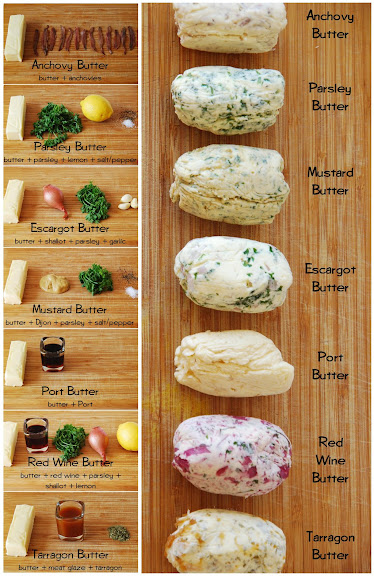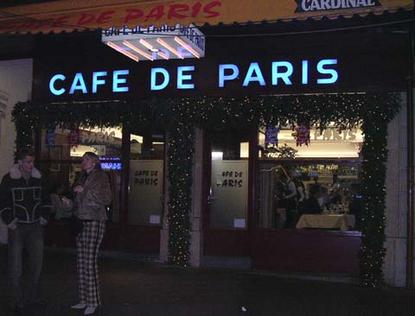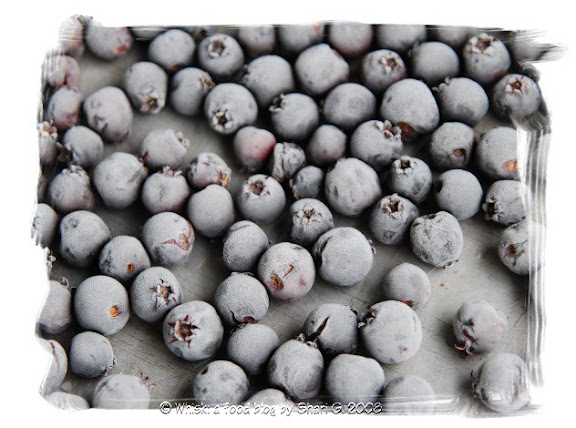.jpg) This month, the Daring Bakers were asked to make chocolate éclairs. I was happy to do it because earlier this year I had made pâte à choux in the form of swans and that became one of my favorite desserts. This version of éclairs consists of three elements: pâte à choux (also known as choux pastry or cream puff dough), chocolate pastry cream, and a chocolate glaze. Instead of making traditional éclairs, I wanted to do something different so I made them into rings, like a Scandinavian wedding cake called Kransekage.
This month, the Daring Bakers were asked to make chocolate éclairs. I was happy to do it because earlier this year I had made pâte à choux in the form of swans and that became one of my favorite desserts. This version of éclairs consists of three elements: pâte à choux (also known as choux pastry or cream puff dough), chocolate pastry cream, and a chocolate glaze. Instead of making traditional éclairs, I wanted to do something different so I made them into rings, like a Scandinavian wedding cake called Kransekage.Kransekage

Kranssi (Finland)
Kransakaka (Iceland)
Kransekake (Norway)
Kranskaka (Sweden)
Kransekage cake, which some say dates back as far as the 1700's, is often served at Scandinavian wedding and anniversary celebrations. For wedding cakes, the bride and groom will sometimes put their hands together over the top pyramid of the cake and break off a number of rings. The number of rings broken off is said to indicate how many children they will produce. For anniversary celebrations, the number of rings on the cake may depict the number of years of marriage being commemorated.
A special pan is usually used to make this cake, but it can also be made with dough rolled into long "snakes" which are formed into circles of varying sizes and baked on a cookie sheet. {I was lucky enough to borrow Kransekage pans from a Scandinavian family friend, Mrs. G, who has used these pans at each of her children’s weddings.} The baked and cooled circles are then stacked to form a pyramid. The pyramid is drizzled and decorated with almond-flavored frosting. The rings are broken into bite-sized pieces for serving.
For this pâte à choux version of Kransekage, I made 12 rings. I wasn't too concerned about evenness as I piped the choux paste, and this had the unintended effect of causing the pyramid to lean as I built it up ring by ring. It seems a miss-shaped ring on the bottom will affect the entire pyramid above. So although it was a little on the crooked side, with practice and patience I'm sure it could look more professional!
Mrs. G's Recipe for Kransekage
(Norwegian Wedding Cake)
1 cup butter
1 cup icing sugar
2 egg yolks
1½ cups sifted flour
1 teaspoon almond flavoring
½ cup almond paste
Sift powdered sugar, and add to butter and cream thoroughly. Beat in egg yolks. Stir in flour, flavoring, and almond paste. Mix until very smooth.
Pipe into Kranse Kage pans. Bake at 350˚F until a delicate brown. Cool. Frost with almond flavored butter frosting or icing sugar frosting.
Chocolate Pastry Cream and Glaze
Back to the pâte à choux…The filling for the pâte à choux is usually a pastry cream (crème pâtissière in French), which is just a fancy name for pudding. It’s a very versatile cream that’s used as a filling in éclairs, tarts, pastries, cream puffs, cakes, and so on. This one has a delicious, rich chocolate flavor. And the chocolate glaze that's drizzled on top is the best I've ever tasted.
I used chocolate from Bernard Callebaut, who is internationally recognized for producing the best chocolate in Canada and throughout the world. When I was in Saskatchewan, I was able to pick up some Callebaut chocolate at one of his locations. After returning to Ottawa, I found out that my favorite local chocolatier, Truffle Treasures, uses Callebaut chocolate in her truffles, and I can buy Callebaut at her store too.
Recipe: Pierre Hermé’s Cream Puff Dough

from Chocolate Desserts by Pierre Hermé
Makes 20-24 Éclairs or 12 rings for a Kransekage
To see the different éclairs, swans, cream puffs {and Kransekages!} cropping up all over the foodblogosphere, check out the Daring Bakers Blogroll. Thanks to Meeta of What’s for Lunch, Honey and Tony Tahhan who hosted this month’s Daring Bakers event.
To make the Pâte à Choux:
In a saucepan, stir together the milk, water, butter, and sugar over medium heat. Bring the mixture to a boil, uncovered. Stir to ensure that everything is mixed and the butter is all melted.
Remove the saucepan from the heat. Add the flour all at once. Stir to incorporate. Beat the mixture until it becomes a ball and pulls away from the sides of the saucepan. Return the saucepan to the heat and cook the paste, stirring continuously, over medium heat until it dries out, about 3 minutes. The paste is dry enough when it leaves a thin, dry film on the bottom of the saucepan.
Remove the saucepan from the heat and allow it to cool for 5 minutes or so. When the dough is cool, add the first egg. Stir the egg into the paste. Initially, the egg and paste will seem not to blend, but after a while they will start to combine. Stir until the paste is a pale yellow, smooth, moist, sticky, and slightly elastic.
Bake at 425˚F for the first 15-20 minutes. Then turn the oven down to about 350˚F and bake them until they are very dry and crisp and a deep golden color throughout. When the shells are done, turn the oven off and leave the door closed. The residual heat will dry and crisp the shells even more.
{Although my pâte à choux failed the first time, collapsing into a heavy dough of eggs and flour after pulling it out of the oven too early, I did a bit of googling and reading, and I was able to make it successfully.}
To make the Chocolate Pastry Cream:
In a small saucepan, bring the milk to a boil. Whisk together the eggs and sugar, then add the cornstarch and combine thoroughly until mixture has lightened in color. Temper in the warm milk and cook to a gentle boil over medium-low heat, whisking constantly until thickened. It should take about 1 minute to come to a boil. Then continue to simmer until smooth and thick, another 1-2 minutes. Stir in the melted chocolate and then remove the pan from the heat and let cool to 140˚F. Add the butter, stirring gently to combine. Once the pastry cream has been chilled, don’t whisk or it will break down the starch.
Need Help? Here’s a video showing how to make pastry cream.
To make the Chocolate Sauce:
Place all the ingredients for the chocolate sauce into a heavy‐bottomed saucepan and bring to a boil, making sure to stir constantly. Then reduce the heat to low and continue stirring with a wooden spoon until the sauce thickens and coats the back of a spoon.
To make the Chocolate Glaze:
In a small saucepan, bring the heavy cream to a boil. Remove from the heat and slowly add the chocolate, stirring with a wooden spoon or spatula.
Stirring gently, stir in the butter, piece by piece followed by the chocolate sauce.
.jpg) Tasting Notes
Tasting NotesThis recipe is so light-tasting, and the chocolate twist was incredible. The pastry cream recipe on its own will be a valuable one to return to for filling a variety of desserts. We enjoyed the leftover glaze and sauce on ice cream, so that’s definitely a keeper too!
Pâte à choux is a magical pastry that is easily one of my favorite desserts.
More to Explore:











.jpg)

.jpg)













.jpg)
.jpg)




.jpg)






